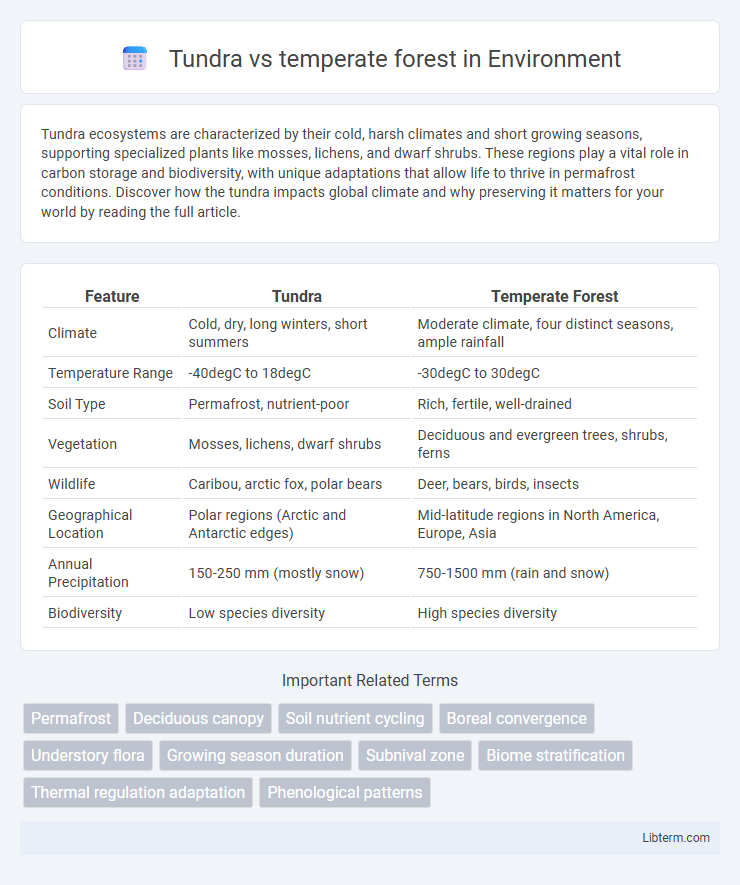Tundra ecosystems are characterized by their cold, harsh climates and short growing seasons, supporting specialized plants like mosses, lichens, and dwarf shrubs. These regions play a vital role in carbon storage and biodiversity, with unique adaptations that allow life to thrive in permafrost conditions. Discover how the tundra impacts global climate and why preserving it matters for your world by reading the full article.
Table of Comparison
| Feature | Tundra | Temperate Forest |
|---|---|---|
| Climate | Cold, dry, long winters, short summers | Moderate climate, four distinct seasons, ample rainfall |
| Temperature Range | -40degC to 18degC | -30degC to 30degC |
| Soil Type | Permafrost, nutrient-poor | Rich, fertile, well-drained |
| Vegetation | Mosses, lichens, dwarf shrubs | Deciduous and evergreen trees, shrubs, ferns |
| Wildlife | Caribou, arctic fox, polar bears | Deer, bears, birds, insects |
| Geographical Location | Polar regions (Arctic and Antarctic edges) | Mid-latitude regions in North America, Europe, Asia |
| Annual Precipitation | 150-250 mm (mostly snow) | 750-1500 mm (rain and snow) |
| Biodiversity | Low species diversity | High species diversity |
Overview of Tundra and Temperate Forests
Tundra ecosystems are characterized by permafrost, low temperatures, and sparse vegetation dominated by mosses, lichens, and dwarf shrubs, supporting specialized wildlife adapted to harsh conditions. Temperate forests feature moderate climates with distinct seasons, dense tree canopies primarily of deciduous and coniferous species, and rich biodiversity including mammals, birds, and insects. These contrasting biomes demonstrate adaptations to climate variability, with tundra soils typically nutrient-poor and temperate forests exhibiting fertile, organic-rich soils.
Geographic Distribution and Climate
Tundras are predominantly found in the high latitudes of the Northern Hemisphere, including parts of Alaska, Canada, Russia, and Scandinavia, characterized by extremely cold temperatures and short growing seasons. Temperate forests occupy mid-latitude regions across North America, Europe, and East Asia, experiencing moderate climates with four distinct seasons and ample precipitation. The tundra's permafrost soil and frigid climate contrast sharply with the temperate forest's fertile soil and milder, more stable weather patterns.
Soil Characteristics and Fertility
Tundra soil is typically thin, acidic, and nutrient-poor with permafrost limiting drainage and root growth, resulting in low fertility. Temperate forest soil is richer in organic matter, well-drained, and supports diverse microbial activity, enhancing nutrient availability and fertility. Seasonal leaf litter decomposition in temperate forests further contributes to soil structure and nutrient cycling, promoting sustained plant growth.
Vegetation Types and Plant Adaptations
Tundra vegetation primarily consists of mosses, lichens, low shrubs, and grasses adapted to short growing seasons, permafrost, and extreme cold, featuring traits such as shallow root systems and antifreeze proteins. Temperate forests exhibit diverse tree species like oaks, maples, and pines with deep roots and broad leaves, adapted to moderate climates and seasonal changes through deciduous shedding or thick, waxy leaves for moisture retention. Plant adaptations in tundra focus on survival under limited sunlight and nutrient-poor soils, while temperate forest plants optimize photosynthesis and water management in variable seasonal conditions.
Wildlife Diversity and Key Species
Tundra ecosystems feature low wildlife diversity, dominated by cold-adapted species such as caribou, arctic foxes, and migratory birds like snow geese. Temperate forests exhibit higher biodiversity with key species including white-tailed deer, black bears, and numerous songbirds, supported by diverse tree species like oaks and maples. The richer plant variety in temperate forests provides abundant habitats and food sources, fostering greater animal diversity compared to the tundra's sparse vegetation.
Seasonal Changes and Environmental Challenges
Tundra ecosystems experience extreme seasonal shifts, with long, harsh winters and short, cool summers causing permafrost and limited plant growth, while temperate forests have four distinct seasons supporting diverse flora and fauna. Seasonal temperature fluctuations in temperate forests enable deciduous trees to shed leaves, conserving water during winter dormancy, contrasting with tundra's adaptation to persistently cold conditions. Environmental challenges in tundras include permafrost thawing and low nutrient availability, whereas temperate forests face threats from invasive species, wildfires, and human-induced habitat fragmentation.
Ecosystem Services and Functions
Tundra ecosystems provide critical regulatory services such as carbon sequestration and climate regulation through their extensive permafrost and low decomposition rates, while supporting unique biodiversity adapted to extreme cold. Temperate forests offer diverse provisioning services including timber, fresh water, and medicinal resources, along with habitat services that sustain rich wildlife populations and facilitate nutrient cycling. Both biomes contribute essential supporting services like soil formation and primary production, yet temperate forests typically exhibit higher productivity and greater ecosystem complexity.
Human Impact and Conservation Efforts
Human impact on tundra ecosystems includes oil drilling, mining, and increased tourism, leading to habitat fragmentation and soil degradation, while temperate forests face deforestation, urbanization, and agriculture expansion causing biodiversity loss and carbon storage decline. Conservation efforts in the tundra prioritize protected areas and limiting industrial activities, whereas temperate forest conservation focuses on sustainable forestry practices, reforestation, and habitat restoration to preserve ecological balance. Both biomes benefit from climate change mitigation strategies and international cooperation to support their resilience and long-term survival.
Climate Change Effects on Both Biomes
Tundra experiences accelerated permafrost thawing and altered precipitation patterns due to rising global temperatures, leading to habitat loss for specialized species and increased greenhouse gas emissions. Temperate forests face shifts in species composition, higher frequency of wildfires, and prolonged droughts as climate change disrupts seasonal cycles and water availability. Both biomes suffer biodiversity decline and ecosystem service disruptions, impacting carbon storage and regional climate regulation.
Key Differences and Ecological Importance
Tundra ecosystems are characterized by permafrost, low temperatures, and limited tree growth, while temperate forests feature moderate climates with deciduous or evergreen trees thriving in fertile soils. The tundra supports specialized flora and fauna adapted to extreme cold and short growing seasons, playing a critical role in carbon storage that mitigates climate change. Temperate forests contribute significantly to biodiversity through diverse plant and animal species and serve as vital carbon sinks, promoting ecological stability and nutrient cycling.
Tundra Infographic

 libterm.com
libterm.com